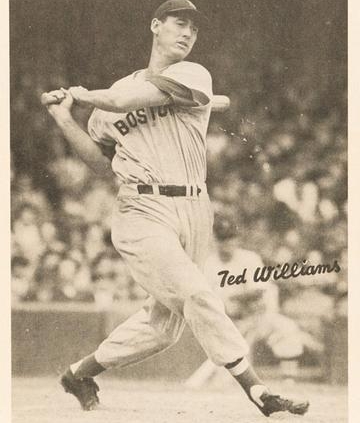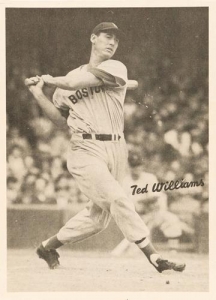May 16, 1947: ‘Nearly as high as it was long’: Ted Williams grand slam proves a game winner
Jack Kramer – who started 1947 with wins in his first three decisions, even though his St. Louis Browns were well under .500 already – was pounded for eight runs in four innings by the Indians on May 11, dealing him his first loss of the season.
But the Browns followed that loss by splitting two games, losing one in New York and coming to Fenway Park on May 15 and picking up a fine 2-1 win for Bob Muncrief. Next was this Friday afternoon game, one that drew 8,639 paying customers and another 3,719 women on ladies day.”1
The Red Sox starter was also 3-1 on the season, right-hander Harry “Fritz” Dorish. The 14-10 Red Sox, the defending American League champions, were only two games behind league-leading Detroit, but the standings were tight: The last-place Browns (8-15) were only 7½ games behind the Tigers. There was still plenty of time in a season only a month old.
Dorish gave up base hits to the first two batters he faced in the first – singles to third baseman Bob Dillinger and center fielder Paul Lehner. He was bailed out by getting first baseman Jerry Witte to ground into a 6-4-3 double play and shortstop Vern Stephens to fly out to right field.
Kramer also gave up a leadoff single, to Red Sox shortstop Eddie Pellagrini. He got Johnny Pesky, playing third base, to line out to left, but then walked Ted Williams. Rudy York singled to left, scoring Pellagrini; Williams took third. Second baseman Bobby Doerr flied out to right field, Williams tagged and scored, and it was 2-0, Red Sox. Center fielder Dom DiMaggio struck out to end the inning.
Dorish got three groundouts in the top of the second. Right fielder Leon Culberson singled leading off for the Red Sox but no one else reached base.
Catcher Les Moss doubled off the left-field wall, leading off the third for the Browns, but three outs followed. In the bottom of the third, the Red Sox scored three more runs. Pesky bunted toward third for a base hit. Williams hit a single to right, moving Pesky to second. York walked. Doerr lined out to center, and Pesky was able to score, increasing the lead to 3-0.
DiMaggio singled to left and Williams scored. Culberson was hit by a pitch, loading the bases again. Catcher Hal Wagner flied out to Lehner in center, and York scored. Kramer struck out Dorish. Boston held a 5-0 advantage.
The Browns got a single and a walk but no runs in the top of the fourth. The Red Sox scored two more runs in their half of the inning. With one out, Pesky singled to right. Williams reached on a throwing error by first baseman Witte, whose throw to second base to try to start a double play went into left field. Pesky scored. York doubled to center and Williams scored. The Red Sox now led 7-0.
A base on balls to Moss was all Dorish allowed in the fifth. Walter Brown came in to pitch for St. Louis in the bottom of the fifth.2 Jake Early replaced Moss and became Brown’s batterymate.
The Red Sox upped the ante and scored four more times that inning. Culberson walked. Wagner and Dorish both made outs. Pellagrini singled, and Culberson went first to third. Pesky walked, loading the bases.
Ted Williams hit a grand slam to deep right field, “a 400 ft. wallop over the Sox bullpen and ten rows high in the right-field bleacher area.”3 It was also a ball hit “nearly as high as it was long.”4 Burt Whitman agreed on the distance and location: “more than 400 feet before falling in the 10th row, or thereabouts, of the very last section of the right-field grandstand.”5 Vic Johnson’s sports-page cartoon in the Herald depicted it landing in what is today Section 1, and it was 11-0, Red Sox. York struck out.6
Though Witte singled and second baseman Johnny Berardino doubled, the Browns still failed to score in the sixth. The Red Sox were scoreless in the bottom of the inning for a change.
Jake Early walked, leading off the St. Louis seventh. Brown struck out. Third baseman Bob Dillinger hit an infield single to third base. Center fielder Paul Lehner hit a three-run homer to right field. The score was a little better from a Browns perspective, but the Red Sox still led 11-3.
Brown retired the side in order in the Red Sox seventh, and Dorish did the same facing St. Louis in the top of the eighth.
Boston picked up one more run in its half of the eighth. Pesky and Williams walked. Brown threw a wild pitch, allowing both baserunners to move up a base. York walked, too. Doerr flied to right and Pesky scored. Brown then got back-to-back groundouts.
In the ninth, the Browns scored four times, making the final score a little more respectable. Red Sox manager Joe Cronin left Dorish in the whole time, though the pitcher was “weakening in the later innings.”7 “Cronin wanted the boy to have the satisfaction of going all the way.”8
Hitting for Brown, Rusty Peters doubled. Dillinger grounded out, but Lehner tripled to right-center. Witte then singled off the wall in left field and Lehner ran home. Vern Stephens homered into the screen above Fenway Park’s left-field wall, his third home run of the season. Dorish closed out the inning getting two more outs. It was his first major-league start – a complete game and a 12-7 win for the Red Sox.
Dorish’s record improved to 4-1. Though Williams’s grand slam off Brown was the game-winner – providing runs 8 through 11 in a 12-7 game – St. Louis starter Kramer, who’d gotten the Browns in a 7-0 hole, was the losing pitcher. He fell to 3-2 for the season.
Doerr drove in three runs without a base hit, on three outfield flies. He also made two putouts and had 10 assists at second base.
It was noted that Ted Williams had resumed hitting to right field. Every base hit in his six previous home games had each been hit to either center or left, but his third-inning single and fifth-inning homer in this game were pulled to right. Whether or not this was simply to prove he could do it is something we cannot know for sure.
Sources
In addition to the sources cited in the Notes, the author consulted Baseball-Reference.com and Retrosheet.org. Thanks to Carl Riechers for supplying the St. Louis Post-Dispatch article.
https://www.baseball-reference.com/boxes/BOS/BOS194705160.shtml
https://www.retrosheet.org/boxesetc/1947/B05160BOS1947.htm
Notes
1 Dent McSkiming, “Browns Bow to Red Sox, 12-7; Williams Wallops Grand Slam Homer,” St. Louis Post-Dispatch, May 16, 1947: 30.
2 It was Brown’s major-league debut, after nine years in the minor leagues. This was his only season in the major leagues and he left with an undefeated (1-0) record, after appearing in 19 games with a 4.89 earned-run average.
3 Melville Webb, “Williams’ Grand Slam Clout Third of Career at Fenway; Dorish Coasts to 12-7 Win,” Boston Globe, May17, 1947: 6.
4 Webb.
5 Burt Whitman, “Ted Grand Slams as Sox Win,” Boston Herald, May 17, 1947: 11.
6 Vic Johnson, cartoon, “Salaam for a Grand Slam,” Boston Herald, May 17, 1947: 11.
7 McSkiming.
8 Webb.
Additional Stats
Boston Red Sox 12
St. Louis Browns 7
Fenway Park
Boston, MA
Box Score + PBP:
Corrections? Additions?
If you can help us improve this game story, contact us.



